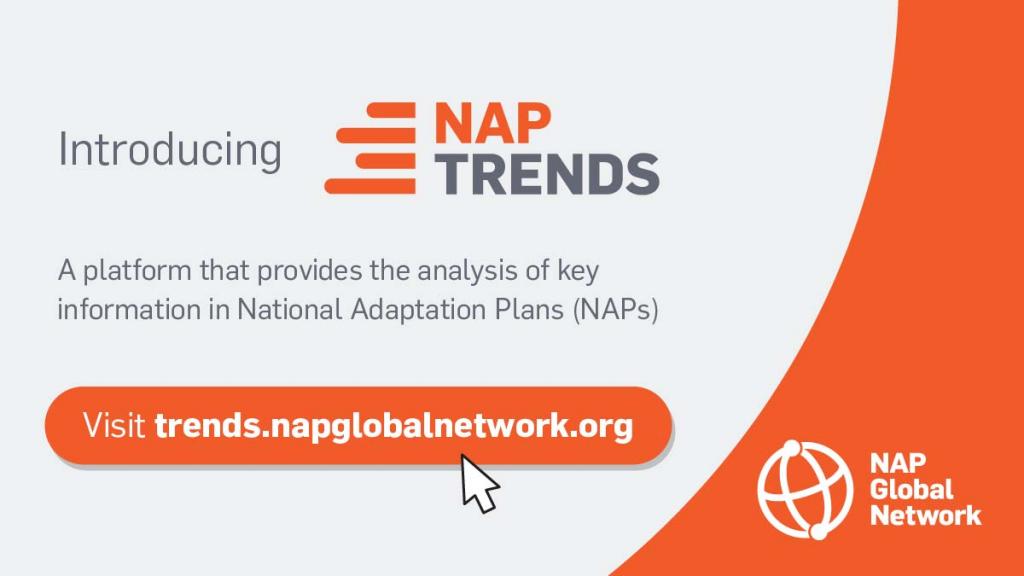Discover Key Trends in How Countries are Planning for Climate Change
April 5, 2022 – The International Institute for Sustainable Development, as host of the NAP Global Network Secretariat, is proud to introduce NAP Trends, a new online platform designed to assist government officials and stakeholders involved in the long-term planning to build a country's resilience to current and future climate change impacts.
NAP Trends provides the analysis of key information in National Adaptation Plans (NAPs) submitted to the United Nations Framework Convention on Climate Change (UNFCCC). The NAP process is a critical tool in a country’s fight to protect its people, ecosystems, and economy from the damaging impacts of climate change, putting in place the systems and capacities needed to make adaptation an integral part of government decision-making.
While climate change affects regions and communities differently, there are valuable lessons that governments can learn from each other as they formulate their NAPs, put them into practice, and develop updated versions.
This work has become even more crucial as new reports urge country leaders to set ambitious, long-term adaptation goals. The Intergovernmental Panel on Climate Change’s (IPCC) Working Group II report in February highlighted an “adaptation gap” that must be addressed to limit climate risks, while stressing the importance of NAPs that cover multiple sectors in order to achieve the best results.
NAP Trends means to facilitate that effort, showcasing what commonalities and differences emerge in how governments are developing their NAPs, such as the themes they prioritize and the sectors they cover. This new platform will assist government officials and stakeholders involved in planning and implementing long-term adaptation actions by providing:
- Content analyses of multi-sector NAPs submitted to the UNFCCC’s NAP Central repository.
- Trends in key themes that emerge across NAPs, such as gender equality, nature-based solutions, and alignment with other sustainable development mechanisms and agendas.
- Statistics that demonstrate an overview of the key issues and priorities in country adaptation plans.
The recent Preview of NAP Trends webinar offers guidance on how to navigate the website.
We invite you to share this platform with colleagues and contacts who are interested in learning how different countries are planning for climate change and where the key trends lie.
Visit the NAP Trends website at trends.napglobalnetwork.org.

A sample of NAP Trends statistics and facts:
- The most mentioned climate hazards in NAPs are droughts, floods, and changes in precipitation patterns.
- 63% of NAPs mention Traditional and Indigenous Knowledge.
- The average number of priority sectors identified in NAPs is nine.
- 97% of NAPs mention gender.
- 80% of NAPs mention ecosystems in vulnerability assessments.
Note: These statistics apply to the NAPs that were submitted to the UNFCCC as of December 2021.
For more information
Interested in national adaptation planning and action news and resources? Sign up for the NAP Global Network’s monthly newsletters and peer exchange opportunities.
All inquiries about the NAP Trends platform can be sent to trends@napglobalnetwork.org.
About the NAP Global Network
The NAP Global Network was created in 2014 to support developing countries in advancing their NAP processes and help accelerate adaptation efforts around the world. To achieve this, the Network facilitates South–South peer learning and exchange, supports national-level action on NAP formulation and implementation, and generates, synthesizes, and shares knowledge. The Network’s members include individual participants from more than 155 countries involved in developing and implementing National Adaptation Plans. Financial support for the Network has been provided by Austria, Canada, Germany, Ireland, the United Kingdom, and the United States. The Secretariat is hosted by the International Institute for Sustainable Development (IISD). For more information, visit www.napglobalnetwork.org.
You might also be interested in
Toolkit for Monitoring, Evaluation, and Learning for National Adaptation Plan Processes
This toolkit provides practical guidance for the development and continuous improvement of MEL systems for national adaptation plan processes to government teams and practitioners working on adaptation.
Four Key Elements to Ensure a Successful Global Goal on Adaptation
As the final rounds of negotiations on the GGA kick off at COP 28, a looming question remains: Will it be comprehensive enough for countries to implement in the years ahead?
Five Ways the Global Goal on Adaptation can Help Build a Global Monitoring, Evaluation, and Learning System for Adaptation by COP 28
With the 58th meeting of the United Nations Framework Convention on Climate Change’s (UNFCCC) Subsidiary Bodies (SBs) due to kick off in Bonn, Germany, on June 5, one of the key issues to watch in the realm of climate change adaptation are the talks on the Global Goal on Adaptation (GGA).
Last Call for the Global Stocktake
The 2023 Bonn Climate Change Conference will be the last opportunity for countries and relevant stakeholders to provide technical inputs into the two-year Global Stocktake process. What are our expectations on adaptation?